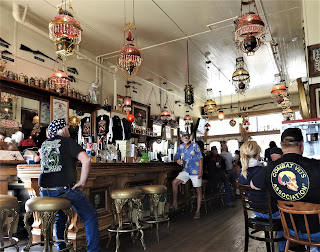There remains but one last day here to explore the sights. Valley of Fire was on Sunday’s agenda but we got delayed by the requisite Sunday “9-1-1 Special breakfast.” At 2PM, with the sun beginning its descent and creating shadows, it became impossible to get a true appreciation of this incredible wonder. So with an extra day to spare, the Valley of Fire was rescheduled for Tuesday.
 |
| Arch Rock |
 |
| Balancing Rock - Who wants to put money on when this thing will fall? |
 |
| Poodle Rock - See him? |
Mother Nature began work on this creation millions of years ago. Volcanos, shifting plates, ice ages, ancient seas and flooding followed by a desert climate continue to take turns changing the landscape of the earth. Valley of Fire is no exception. The colors derive from sandstone, silica, gypsum, iron, manganese and a host of additional elements that create the reds, whites, tans and blacks that we now see. Much later, at the time of the dinosaurs, the area was covered by as much as 3,000 feet of sand that held everything in place. As the winds blew the sands about, the rock formations stayed behind in the spectacular formations that we see today. (That’s the Reader’s Digest version.)
 |
| 18 feet deep sealed chasm called "Mouse's Tank" |
 |
| Hiking on Mouse's Tank trail |
 |
| Wuhan Virus petroglyph |
 |
| Rob and the Higher Glyphs |
 |
| Some of the many petroglyphs on Mouse's Tank trail |
 |
| Sergeant John J. Clark's memorial |
 |
| Rob and the 1930s version of the Holiday Inn Express |
In more recent decades (1930s), the Civilian Conservation
Corps built a few small cabins along the pathways to shelter weary
travelers. The cabins were not furnished
with much, just a dirt floor and a fireplace but they provided respite from the
unforgiving desert elements. And they
did offer free wi-fi.
 |
| White Dome - comprised of gypsum, mostly |
It is easy to spend several days in the Valley of Fire, hiking to the more famous of the rock formations and stopping for a sip of water and a sandwich at one of the picnic areas overlooking the spectacular vistas. It was a wonderful place to spend peaceful hours soaking in Mother Nature’s tireless creativity.
That’s all for this time. Time to pack up Noobee and head back to the insanity. Thanks to all of you, my dear t-loggers, for coming along on this little getaway. I send you hugs and kisses, even if they are illegal and of course lots of love! Have a wonderful holiday season!











































